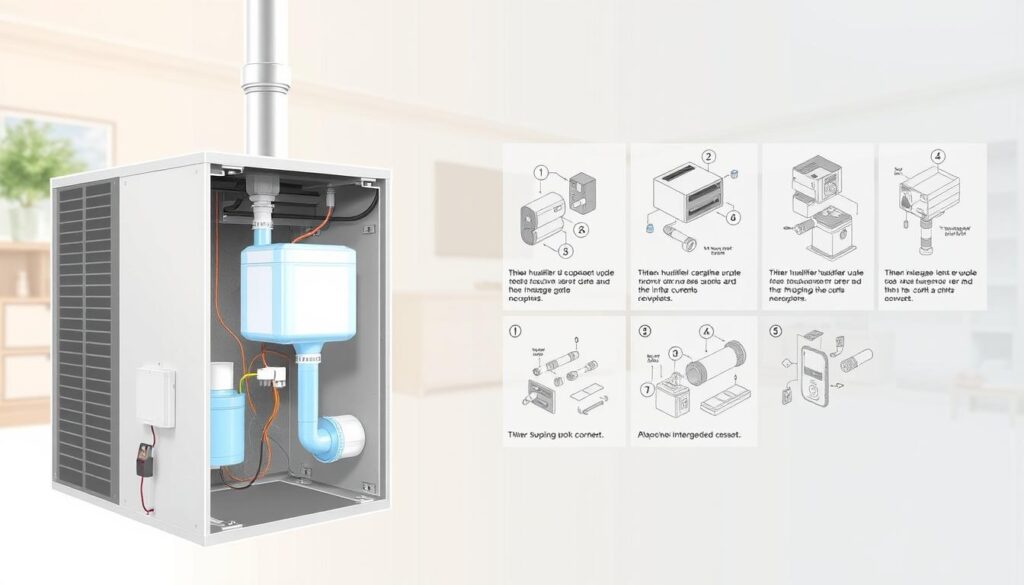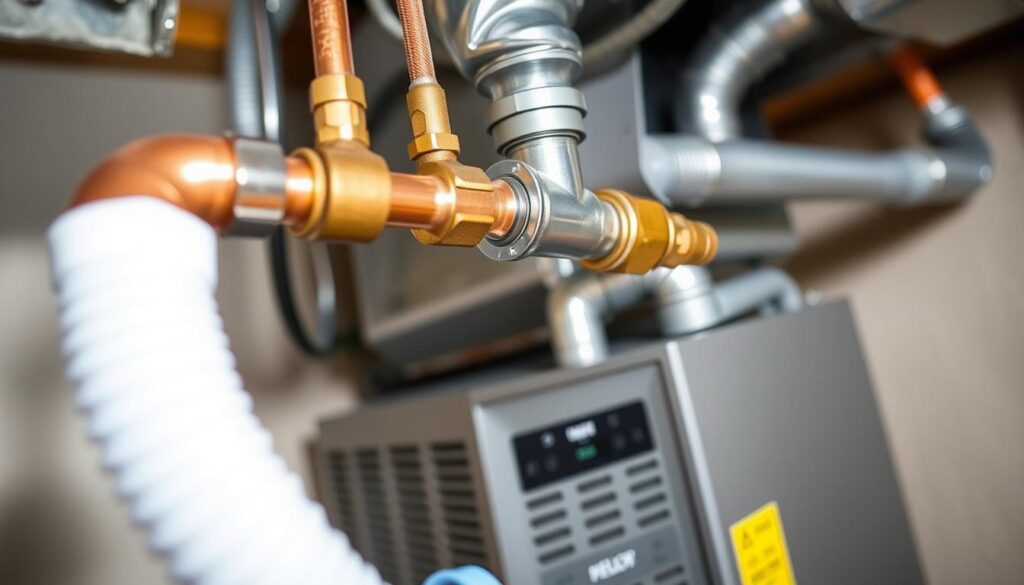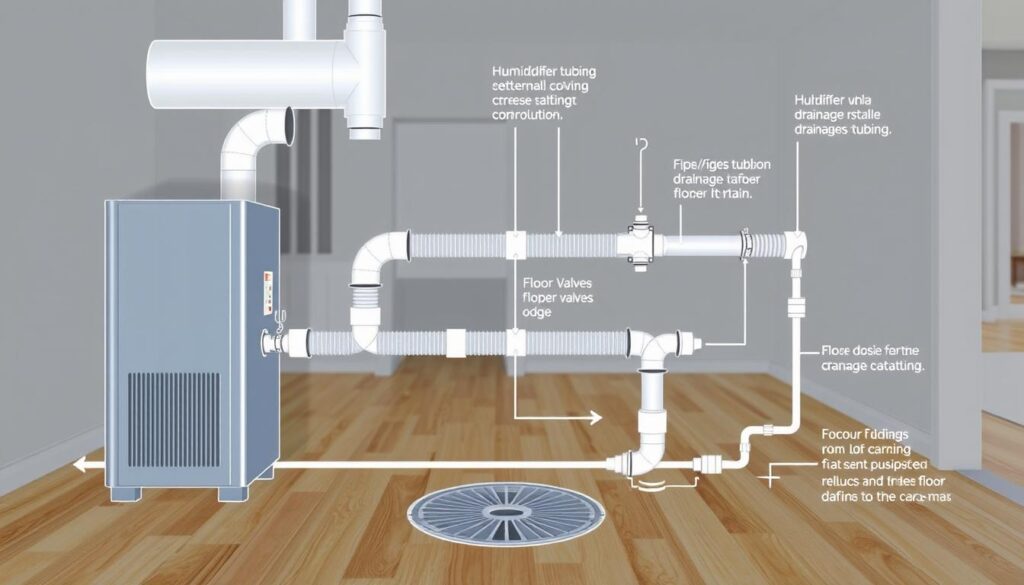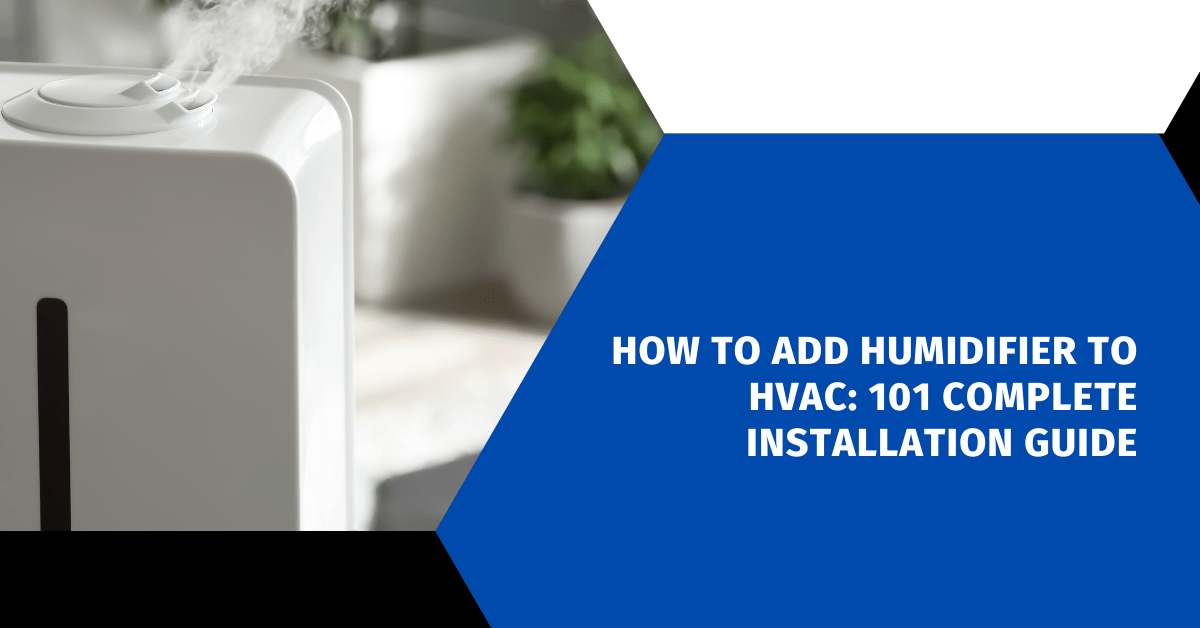Affiliate Disclosure
HVAC Guide Guys is a participant in the Amazon Services LLC Associates Program, an affiliate advertising program designed to provide a means for sites to earn advertising fees by advertising and linking to Amazon.
How to Add Humidifier to HVAC? Are you tired of dry air making your home feel uncomfortable and causing respiratory issues? What if you could transform your living space with a simple HVAC humidifier installation that dramatically improves your indoor air quality?

Adding a humidifier to your HVAC system can be a game-changer for home comfort. This comprehensive guide will walk you through the entire process of how to add humidifier to HVAC, ensuring you have all the knowledge needed for a successful hvac humidifier installation.
Whether you’re a DIY enthusiast or a homeowner looking to enhance your living environment, this guide provides step-by-step insights into selecting, installing, and maintaining a whole-house humidification system.
Key Takeaways
- Learn the essential steps for HVAC humidifier installation
- Understand the benefits of whole-house humidity control
- Discover tools and techniques for professional-quality installation
- Improve indoor air quality and home comfort
- Save money with a strategic DIY approach
Table of Contents
Understanding HVAC Humidifier Benefits and Types
Keeping your home’s humidity at the right level is key for comfort and health. HVAC systems help control humidity, making your home a better place to live. Using a residential humidifier for your HVAC system is a smart way to manage moisture in your home.
There are many choices for improving your home’s humidity. Each type of humidifier has its own benefits for your air quality and comfort.
Types of Whole-House Humidifiers
- Bypass Humidifiers: Use warm air from your HVAC to spread moisture
- Fan-Powered Humidifiers: Spread moisture more efficiently
- Steam Humidifiers: Control humidity precisely, without relying on your HVAC
Advantages of HVAC Humidification
Adding a humidifier to your HVAC system has many benefits:
- It cuts down on static electricity
- It keeps wood furniture safe from dry air damage
- It makes your home more comfortable
Impact on Indoor Air Quality
| Humidity Level | Health Impact | Comfort Level |
|---|---|---|
| 30-50% | Best for breathing | Most comfortable |
| Below 30% | Can cause breathing problems | Feels dry and uncomfortable |
| Above 60% | May lead to mold | Feels sticky and uncomfortable |
Using the right humidifier can greatly improve your home’s air quality. It can help reduce breathing issues and make your home a healthier place.
Explore Our HVAC Shop
Looking for top-rated HVAC tools, parts, and accessories? Visit our shop and find the perfect solution for your needs.
Visit the ShopEssential Tools and Materials Needed
Getting ready to add a humidifier to your heating and cooling system needs careful planning. You’ll also need the right tools and materials. Before starting, make sure you have everything you need for a smooth setup.
- Measuring and Marking Tools
- Level
- Marker
- Measuring tape
- Cutting and Drilling Equipment
- Drill with various bits
- Aviation snips
- Fastening Tools
- Phillips and flathead screwdrivers
- Adjustable wrench
- Pliers
For a successful humidifier installation, you’ll need specific materials. These are designed to work with your HVAC system:
| Category | Required Materials |
|---|---|
| Humidification Equipment | Whole-house or bypass humidifier with placement kit |
| Connection Components | Water supply line and fittings |
| Electrical Components | Low-voltage thermostat wire |
| Mounting Hardware | Mounting screws and wall anchors |
Pro Tip: Always wear protective gear like work gloves and safety glasses when working with HVAC systems. Make sure you have all materials before starting. This will help avoid delays.
Proper preparation is the key to a successful humidifier installation in your heating and cooling system.
Explore Our HVAC Shop
Looking for top-rated HVAC tools, parts, and accessories? Visit our shop and find the perfect solution for your needs.
Visit the ShopSelecting the Right Humidifier for Your System
Choosing the right humidifier for your HVAC system is important. You want to manage moisture well and ensure your system works smoothly.
Choosing the right whole-house humidifier means knowing your home and system needs. It might seem hard, but focusing on key points makes it easier.
Size and Capacity Considerations
Your home’s size affects humidifier choice. Think about these important factors:
- Total living space square footage
- Ceiling height
- Local climate characteristics
- Number of rooms
Energy Efficiency Ratings
Energy efficiency is key when choosing a humidifier. Look for high-performance units that use less electricity.
| Efficiency Rating | Energy Consumption | Recommended Use |
|---|---|---|
| High (90-100%) | Low | Large homes, consistent humidity needs |
| Medium (70-89%) | Moderate | Average-sized homes |
| Low (50-69%) | High | Small spaces, occasional use |
Budget and Installation Costs
Buying a quality humidifier means knowing costs upfront. Prices vary from $300 to $1,500, based on features and complexity.
“The right humidifier balances performance, efficiency, and cost-effectiveness.” – HVAC Professional
When looking at moisture management options, think about long-term savings. A more expensive unit might save money by using less energy.
Pre-Installation Safety Measures
Safety is key when installing an HVAC humidifier. You must protect yourself and your equipment before starting any indoor air quality project.
Before you start, take important safety steps to avoid accidents or damage to your HVAC system:
- Turn off power to the HVAC system at the main circuit breaker
- Verify electrical disconnection by attempting to activate system controls
- Wear appropriate personal protective equipment (PPE)
- Ensure proper workspace ventilation
- Have a fire extinguisher nearby
Wearing the right gear is essential for your safety during installation. Always wear:
- Safety glasses to protect eyes from debris
- Work gloves to prevent cuts and abrasions
- Dust mask to filter potential airborne particles
- Long-sleeve shirt and pants for skin protection
“Proper preparation prevents poor performance and potential injuries.”
It’s also important to check your workspace. Make sure it’s clean, well-lit, and free from hazards. Remove any tools or materials that could cause problems during installation.
By following these safety steps, you’ll ensure a safe environment for your HVAC humidifier installation. This will help avoid risks and make the setup smooth and professional.
How to Add Humidifier to HVAC
Adding a whole-house humidifier to your HVAC system needs careful planning. You must follow specific steps for proper integration and best performance.
Before starting, gather all tools and review your HVAC system’s details. Good preparation is essential for a successful installation.
Marking Installation Location
Choosing the right spot for your humidifier is key. Look for a place that:
- Is close to your ductwork
- Ensures good airflow
- Doesn’t block other system parts
Cutting Access Holes
When cutting holes, precision is vital. Here’s what to do:
- Measure twice before cutting
- Use the manufacturer’s template for exact measurements
- Wear protective safety gear
- Make clean, straight cuts in the ductwork
Mounting Bracket Installation
Mounting your humidifier correctly is crucial. For mounting brackets:
- Make sure the surface is level
- Use the right mounting hardware
- Ensure brackets can hold the humidifier’s weight
- Check alignment with your ductwork
Pro Tip: Always check your humidifier’s manual for specific needs and recommendations.
Explore Our HVAC Shop
Looking for top-rated HVAC tools, parts, and accessories? Visit our shop and find the perfect solution for your needs.
Visit the ShopWater Supply Line Installation

Installing the water supply line is a key step in setting up your HVAC humidifier. Your system needs a steady water supply to work well. This is especially true when you’re adding a humidifier to your heating and cooling system.
Before you start, make sure you have these important tools:
- Adjustable wrench
- Copper tubing cutter
- Compression fittings
- 1/4-inch copper tube
Find the nearest cold water pipe in your home. You’ll need to use either a saddle valve or T-fitting to connect the water. HVAC experts suggest following these steps carefully:
- Find the closest cold water pipe
- Clean the pipe well
- Put in the valve with the right fittings
- Connect 1/4-inch copper tubing to the valve
- Make sure compression fittings are tight and secure
“Proper water line installation is crucial for maintaining your humidifier’s performance and longevity.” – HVAC Installation Experts
When you run the copper tube to your humidifier, use compression fittings for a leak-free seal. Always check local building codes to make sure you’re following the rules for water line installation.
| Connection Type | Recommended Usage | Difficulty Level |
|---|---|---|
| Saddle Valve | Residential HVAC Systems | Easy |
| T-Fitting | Complex Plumbing Setups | Moderate |
Don’t forget to test your water connection well. This is to avoid leaks or water damage during your HVAC humidifier installation.
Electrical Connections and Wiring
Adding a humidifier to your HVAC unit needs careful electrical work. You must make precise connections for your humidifier to work right.
Before starting any electrical work, safety is key. Follow these important steps for a safe installation:
- Shut off power to your HVAC system completely
- Verify electrical circuit is de-energized using a voltage tester
- Wear protective electrical work gloves
- Have proper wire strippers and electrical tape ready
Power Supply Requirements
Most whole-house humidifiers need a 24-volt power supply from your HVAC system’s control board. You’ll need to find the right terminals for your new device.
Control Panel Setup
Connecting your humidifier requires careful wiring. You’ll connect to the “C” (common) and “W” (heat) terminals on your control board. Use wire nuts to secure connections and electrical tape for extra insulation.
“Proper electrical connections are the foundation of a reliable HVAC humidification system.” – HVAC Professional
Thermostat Integration
Modern humidifiers can connect with smart thermostats for easy control. Check if your thermostat works with humidifiers and follow the instructions for wireless or direct-wire connections.
- Verify thermostat supports humidifier functions
- Confirm correct wiring configuration
- Test communication between devices
If you’re unsure about any electrical connection, it’s best to get help from a professional HVAC technician. They can ensure your installation is safe and correct.
Bypass Duct Installation Steps
Installing a bypass duct is key for good hvac humidification. It needs careful steps to manage moisture well in your home’s heating and cooling.
Before starting, make sure you have these tools:
- Aviation snips
- Sheet metal screws
- Measuring tape
- Drill
- Protective gloves
Here are the main steps for a successful bypass duct installation:
- Mark the exact spot for a six-inch bypass line
- Make a starter hole in the ductwork
- Cut the vent hole with aviation snips
- Put in a round collar with sheet metal screws
- Measure and cut the vent pipe to fit perfectly
It’s important to place the bypass duct right for good air flow. Make sure it connects well between your humidifier and the main HVAC system. This helps avoid air leaks.
| Installation Step | Key Considerations |
|---|---|
| Hole Cutting | Use precise measurements to prevent system inefficiency |
| Collar Placement | Secure firmly with multiple sheet metal screws |
| Duct Alignment | Verify perfect connection between humidifier and HVAC system |
Pro Tip: Always double-check your measurements and connections. This ensures your hvac humidification system works its best.
Explore Our HVAC Shop
Looking for top-rated HVAC tools, parts, and accessories? Visit our shop and find the perfect solution for your needs.
Visit the ShopSetting Up the Drainage System

When you install a residential humidifier for HVAC, setting up a good drainage system is key. It stops water damage and keeps the system running well. You need to plan and do it right.
Your HVAC humidifier needs a drain line that keeps water flowing smoothly. Choose a 1/2-inch hose that fits your humidifier. Make sure the line slopes down to avoid water pooling.
- Find a good spot for the drainage near your HVAC system
- Make sure the slope is at least 1/4 inch per foot
- Don’t have sharp bends or kinks in the hose
- Check local building codes for drainage rules
When you lay out the drain line, remember these important points:
| Drainage Consideration | Recommended Action |
|---|---|
| Drainage Location | Floor drain, utility sink, or condensate pump |
| Slope Requirement | Minimum 1/4 inch downward per foot of horizontal run |
| Hose Material | Flexible, non-corrosive PVC or recommended manufacturer material |
Warning: Bad drainage can cause water damage, mold, and lower humidifier efficiency. Make sure to install the drain line correctly.
Professional tip: Think about getting a condensate pump if gravity drainage is hard in your HVAC setup.
Check your drainage system often to keep your humidifier working well and avoid water problems.
Testing and Calibration Procedures
After setting up your HVAC humidity control, it’s important to test it thoroughly. This ensures your indoor air quality is at its best. The last steps involve checking and adjusting everything to work perfectly.
Initial System Check
Start by inspecting your system carefully. Here are some key steps:
- Activate power outlet and water source
- Open the saddle valve completely
- Check all connection points for potential leaks
- Verify drain line functionality
Humidity Level Adjustment
Adjusting humidity levels is crucial for control. Set your humidistat within these ranges:
- Winter: 30-40% relative humidity
- Summer: 50-55% relative humidity
Performance Verification
To check if your system works well, use a digital hygrometer. Measure moisture levels in different rooms. This tool shows if your air quality efforts are paying off.
Regular checks keep your home comfortable and air quality high.
Look out for signs of wrong humidity levels. These include condensation on windows or dry skin. They mean you need to adjust your system.
Maintenance and Care Guidelines
Keeping your HVAC humidifier in good shape is key. It ensures your system works well and keeps the air clean inside. Regular care stops problems before they start and makes your humidifier last longer.
Your HVAC moisture system needs regular checks to work its best. Here are some important steps to keep your humidifier running smoothly:
- Replace water panels or pads every 3-6 months
- Clean the humidifier unit monthly to prevent mineral buildup
- Inspect electrical connections quarterly
- Check for water leaks and drainage issues
- Verify humidity levels with a hygrometer
Seasonal care is especially important for your HVAC humidifier. Winter and summer bring different challenges that need special attention.
| Maintenance Task | Frequency | Purpose |
|---|---|---|
| Water Panel Replacement | Every 3-6 months | Prevent mineral accumulation |
| Electrical Connection Check | Quarterly | Ensure safe operation |
| Unit Cleaning | Monthly | Maintain system efficiency |
Pro tip: Keep a maintenance log to track your humidifier’s performance and schedule regular inspections.
By sticking to these tips, you’ll get the most out of your HVAC moisture system. You’ll also improve the air quality inside and avoid expensive fixes.
Conclusion
Adding a humidifier to your HVAC system can greatly improve your home’s air quality. The steps to add a humidifier need careful planning and technical skills. Some homeowners might feel ready to do it themselves, while others might want professional help.
Your home’s comfort and health depend on the right installation and maintenance. Choosing the right humidifier model and following the manufacturer’s guidelines are key. If you need help, HVAC technicians can offer expert advice.
A well-installed HVAC humidifier brings many benefits. It can improve your breathing, reduce static electricity, and protect your wooden furniture. Regular maintenance keeps your humidifier working well for a long time.
Understanding how to install a humidifier can make your home more comfortable and healthy. Remember, every home is different. Talking to HVAC professionals can help you choose the best option for your home.
FAQ
What are the main benefits of adding a humidifier to my HVAC system?
How do I know which type of humidifier is best for my home?
Can I install a whole-house humidifier myself, or should I hire a professional?
How much does it cost to add a humidifier to my HVAC system?
What are the main benefits of adding a humidifier to my HVAC system?
How do I know which type of humidifier is best for my home?
Can I install a whole-house humidifier myself, or should I hire a professional?
How much does it cost to add a humidifier to my HVAC system?
FAQ
What are the main benefits of adding a humidifier to my HVAC system?
A humidifier improves indoor air quality and reduces static electricity. It also protects wood furnishings and may help with respiratory issues. It keeps humidity levels right, making your home more comfortable and possibly saving energy.
How do I know which type of humidifier is best for my home?
The right humidifier depends on your home’s size, climate, and HVAC system. Bypass humidifiers are good for mild climates. Fan-powered ones are best for big spaces. Steam humidifiers offer the most control. Think about your home’s size and humidity needs, and talk to an HVAC expert.
Can I install a whole-house humidifier myself, or should I hire a professional?
If you’re good at DIY and have plumbing and electrical skills, you might install a humidifier. But, complex systems or electrical connections are best left to pros. They ensure it’s done right and avoid damage.
How much does it cost to add a humidifier to my HVAC system?
Prices range from 0 to
FAQ
What are the main benefits of adding a humidifier to my HVAC system?
A humidifier improves indoor air quality and reduces static electricity. It also protects wood furnishings and may help with respiratory issues. It keeps humidity levels right, making your home more comfortable and possibly saving energy.
How do I know which type of humidifier is best for my home?
The right humidifier depends on your home’s size, climate, and HVAC system. Bypass humidifiers are good for mild climates. Fan-powered ones are best for big spaces. Steam humidifiers offer the most control. Think about your home’s size and humidity needs, and talk to an HVAC expert.
Can I install a whole-house humidifier myself, or should I hire a professional?
If you’re good at DIY and have plumbing and electrical skills, you might install a humidifier. But, complex systems or electrical connections are best left to pros. They ensure it’s done right and avoid damage.
How much does it cost to add a humidifier to my HVAC system?
Prices range from $200 to $1,500, based on the humidifier type, home size, and installation. Bypass humidifiers are cheaper, while steam ones cost more. Professional installation adds $300 to $500. Think about long-term savings and comfort.
How often do I need to maintain my HVAC humidifier?
Keep it in top shape with regular care. Change water panels or pads yearly, at heating season start. Clean it every few months to avoid mineral buildup. Check electrical and drainage systems quarterly. During busy months, inspect it monthly for wear or issues.
What humidity level should I maintain in my home?
Keep humidity between 30% and 50%. In winter, aim for 30-40% to avoid condensation. Summer can handle up to 50%. Use a hygrometer to check levels and adjust your humidifier. Stay below 60% to avoid mold.
Are there any safety concerns with HVAC humidifiers?
Always turn off power before installing a humidifier. Wear proper gear and ensure good ventilation. Be careful with electrical parts and follow the manufacturer’s instructions. Regularly check for leaks or electrical issues. If unsure, get a pro.
Can a humidifier help with health issues?
Yes, a well-maintained humidifier can help with health problems. It can reduce respiratory issues, prevent dry skin, and lower static electricity. It may also help with allergies, asthma, and sinus problems. It makes your home healthier and more comfortable.
,500, based on the humidifier type, home size, and installation. Bypass humidifiers are cheaper, while steam ones cost more. Professional installation adds 0 to 0. Think about long-term savings and comfort.
How often do I need to maintain my HVAC humidifier?
Keep it in top shape with regular care. Change water panels or pads yearly, at heating season start. Clean it every few months to avoid mineral buildup. Check electrical and drainage systems quarterly. During busy months, inspect it monthly for wear or issues.
What humidity level should I maintain in my home?
Keep humidity between 30% and 50%. In winter, aim for 30-40% to avoid condensation. Summer can handle up to 50%. Use a hygrometer to check levels and adjust your humidifier. Stay below 60% to avoid mold.
Are there any safety concerns with HVAC humidifiers?
Always turn off power before installing a humidifier. Wear proper gear and ensure good ventilation. Be careful with electrical parts and follow the manufacturer’s instructions. Regularly check for leaks or electrical issues. If unsure, get a pro.
Can a humidifier help with health issues?
Yes, a well-maintained humidifier can help with health problems. It can reduce respiratory issues, prevent dry skin, and lower static electricity. It may also help with allergies, asthma, and sinus problems. It makes your home healthier and more comfortable.

